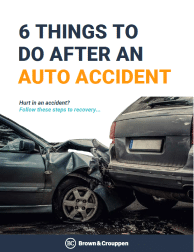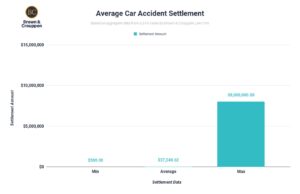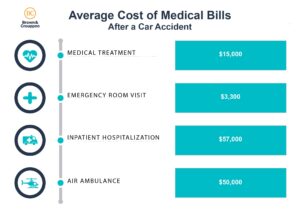Missouri follows a pure comparative negligence (at-fault) system, which allows individuals to recover damages after an accident even if they are partially at-fault. However, the compensation will be reduced proportionately by the driver’s percentage of fault in the accident.
For example, in a pure comparative negligence system, if you’re found to be 60% at-fault for an accident, you may be entitled to 40% of the compensation. If you or a loved one has been injured in an accident, get help from the attorneys at Brown & Crouppen Law Firm. Request a free case evaluation by calling (800) 536-4357 or by completing online form.
Understanding the 3 Types of Negligence
1. Pure Comparative Negligence
Under pure comparative negligence, each party’s liability for damages is determined based on their percentage of fault, regardless of how much they contributed to the accident. Plaintiffs can recover damages even if they are mostly at fault, but their award is reduced by their percentage of fault.
Missouri is one of about a dozen states that use a pure comparative negligence system. This system is considered to be the most liberal approach, as it allows plaintiffs to recover damages even if they are primarily responsible for an accident.
To illustrate, suppose a court finds that a plaintiff was injured in a car accident and is entitled to $1 million in damages. However, the court also determines that the plaintiff was 30 percent at fault for the accident. In this case, the plaintiff would receive $700,000, reflecting their share of responsibility for the accident. If they were held 60 percent at fault, their compensable damages would be reduced further to $400,000.
2. Modified or Partial Comparative Negligence
Modified comparative negligence follows the same principle as pure comparative negligence but with a key restriction: plaintiffs can only recover damages if their degree of fault falls below a certain threshold. It is the most common system across U.S. jurisdictions.
There are two main variations of modified comparative negligence:
- 50 Percent Bar Rule – Under this rule, plaintiffs cannot recover damages if they are found to be 50 percent or more at fault for the accident. If their fault is less, they can recover damages, but their award is reduced by their percentage of fault.
- 51 Percent Bar Rule – Under this rule, plaintiffs cannot recover damages if they are found to be 51 percent or more at fault for the accident. If their fault is less, they can also recover damages, but their award is again reduced by their percentage of fault.
Modified comparative negligence attempts to strike a balance between pure comparative negligence and contributory negligence by imposing a threshold beyond which plaintiffs are barred from recovery.
3. Contributory Negligence
Contributory negligence is a harsh rule and less commonly used in modern legal systems due to its potential for unfair outcomes. Only five U.S. jurisdictions hang onto the old-fashioned doctrine of contributory negligence—Alabama, Maryland, North Carolina, Virginia, and Washington, D.C. It was abolished by the Missouri Supreme Court in 1983.


Use our legal checklist to learn what to do after an accident and understand key legal considerations for recovering financial compensation.
How Do I Prove Fault?
As a general legal concept, negligence refers to the failure to exercise a level of care that a reasonable person would in similar circumstances. To establish negligence and prove fault after an auto accident, plaintiffs must prove four elements:
- Duty of care – The defendant must owe a duty of care to the plaintiff. The duty of care is a legal obligation imposed on individuals or entities to act reasonably and prudently to prevent foreseeable harm to others.
- Breach of duty – The defendant must have breached the duty of care owed to the plaintiff. This means they failed to act as a reasonable person would under the circumstances.
- Causation – The breach of duty must be the direct cause of the plaintiff’s injury or harm. There are two important aspects of the causation element—(1) cause in fact (but for the defendant’s actions, the harm would not have occurred) and (2) proximate cause (the harm was a foreseeable result of the defendant’s actions).
- Damages – The plaintiff must have suffered actual harm or damages as a result of the defendant’s breach of duty. This could include physical injuries, emotional distress, financial loss, or damage to property.
Subject to the pure comparative negligence standard described above, if all four elements of negligence are present, Missouri courts may hold defendants liable for compensating plaintiffs for their damages. However, it’s important to note that the contours of the standard of care can vary widely depending on the specific circumstances of each case.
What Evidence Will I Need to Prove Fault?
Various types of evidence may be used to substantiate a negligence claim. Some important types of evidence include:
- Documentary evidence – Documents such as contracts, medical records, accident reports, emails, photographs, and videos can provide crucial information about the incident and its aftermath. These documents can help establish the facts of the case and demonstrate the extent of the damages suffered by the plaintiff.
- Physical evidence – Physical evidence such as damaged property, skid marks at an accident scene, or defective products can provide important clues about what happened and who may be responsible.
- Witness Testimony – Testimony from individuals who observed the events leading up to the injury or who have relevant knowledge about the circumstances can be valuable.
- Expert testimony – Expert witnesses, such as accident reconstructionists, medical professionals, engineers, or other specialists, can provide opinions based on their specialized knowledge to help the court understand complex issues or establish the standard of care in a particular situation.
- Circumstantial evidence – Circumstantial evidence, such as the timing of events, the behavior of the parties involved, or patterns of conduct, can help to infer what happened when direct evidence is lacking.
- Defendant’s statements – Statements made by the defendant, either during the incident or afterward, can be important evidence in establishing their state of mind, awareness of risks, or admission of fault.
- Prior incidents or patterns – Evidence of prior similar incidents or a pattern of behavior by the defendant can help establish negligence, especially if it demonstrates a history of disregarding safety or failing to meet the required standard of care. However, your attorney will have to carefully review the legal relevance and admissibility of this kind of evidence.
Gathering and presenting compelling evidence is essential for proving a claim of negligence. However, each case is unique, and the types of evidence important to your case will depend on the specific circumstances and the legal theories involved.


Were you injured in an accident due to someone else’s negligence? Get legal help from the most effective injury law firm in the Midwest.
Joint and Several Liability Under Missouri’s Negligence Laws
When held “jointly and severally liable,” defendants share responsibility for compensating victims. Missouri law specifically addresses joint and several liability among negligent defendants:
[I]f a defendant is found to bear 51 percent or more of fault, [they] shall be jointly and severally liable for the amount of the judgment rendered against [all] defendants. If a defendant is found to bear less than 51 percent of fault, [they] shall only be responsible for the percentage of the judgment for which [they are] determined to be responsible.
Get a Free Consultation From Our Auto Accident Lawyers at Brown & Crouppen
Our award-winning law firm is dedicated to serving our community by providing top-tier legal representation to personal injury victims in St. Louis, Kansas City, and throughout Missouri. Because of the high quality of our services and dedication to our clients, we have been recognized by the St. Louis Post-Dispatch as the Best Law Firm in St. Louis.
No matter the circumstances of your case, we are here to make sure you know your full legal rights and options. Our skilled attorneys will evaluate your situation and explain how Missouri negligence laws apply to your case.
Call us at (800) 536-4357 or contact us online to schedule your free consultation. There are no upfront costs to work with us, and you pay nothing unless we win your case.








